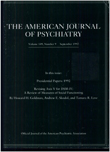Somatization: a spectrum of severity
Abstract
OBJECTIVE: The DSM-III-R diagnosis of somatization disorder requires that a patient have a specific number of medically unexplained somatic symptoms. This number of symptoms was developed by committee consensus, and it is not clear whether patients with this specific number of symptoms can be differentiated from patients with lower but still substantial numbers of somatic symptoms. METHOD: Fifty-one percent of 767 high utilizers of two primary care clinics were identified as distressed by an elevated SCL anxiety, depression, or somatization scale score or by their primary care physician. The Diagnostic Interview Schedule (DIS) was completed on 119 distressed high utilizers who were randomly assigned to an intervention group in a controlled trial of psychiatric consultation. The 119 distressed high utilizers were separated into four categories according to the number of unexplained somatic symptoms found on the DIS and were compared on demographic, psychiatric distress, disability, medical, and health utilization variables. RESULTS: The data suggest that many clinical and behavioral features of somatization are significantly more common in patients with four to 12 medically unexplained somatic symptoms rather than changing dramatically at the diagnostic threshold for somatization disorder. The data also showed that patients who meet the DSM-III-R criteria for somatization disorder are severely ill and have a high burden of psychiatric illness and disability. CONCLUSIONS: The results suggest that the DSM-IV somatoform disorders section should include somatization disorder, an abridged definition of somatization disorder often associated with anxiety and depression, as well as a type of somatization associated with an adjustment disorder.
Access content
To read the fulltext, please use one of the options below to sign in or purchase access.- Personal login
- Institutional Login
- Sign in via OpenAthens
- Register for access
-
Please login/register if you wish to pair your device and check access availability.
Not a subscriber?
PsychiatryOnline subscription options offer access to the DSM-5 library, books, journals, CME, and patient resources. This all-in-one virtual library provides psychiatrists and mental health professionals with key resources for diagnosis, treatment, research, and professional development.
Need more help? PsychiatryOnline Customer Service may be reached by emailing [email protected] or by calling 800-368-5777 (in the U.S.) or 703-907-7322 (outside the U.S.).



